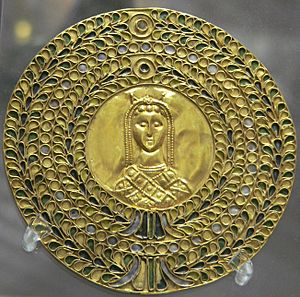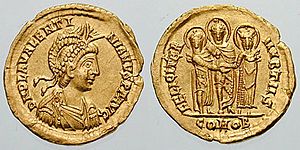Licinia Eudoxia facts for kids
Quick facts for kids Licinia Eudoxia |
|||||||||
|---|---|---|---|---|---|---|---|---|---|
| Empress of the Western Roman Empire | |||||||||

Golden medallion with portrait of Licinia Eudoxia.
|
|||||||||
| Empress of the Roman Empire (in the West) | |||||||||
| Tenure | 437–455 | ||||||||
| Born | 422 Constantinople (modern-day Istanbul, Turkey) |
||||||||
| Died | c. 493 (aged ~71) Constantinople (modern-day Istanbul, Turkey) |
||||||||
| Spouse | Valentinian III Petronius Maximus |
||||||||
| Issue | Eudocia Placidia |
||||||||
|
|||||||||
| Dynasty | Theodosian | ||||||||
| Father | Theodosius II | ||||||||
| Mother | Aelia Eudocia | ||||||||
Licinia Eudoxia (born 422 – died around 493) was a powerful Roman Empress. She was the daughter of Theodosius II, who was the Emperor of the Eastern Roman Empire. Licinia Eudoxia married two different Western Roman Emperors: Valentinian III and Petronius Maximus. Her life was full of important events in the history of the Roman Empire.
Contents
Her Family Background
Licinia Eudoxia was born in 422. Her father was Theodosius II, the Eastern Roman Emperor. Her mother was Aelia Eudocia, who came from a Greek family. Eudoxia had two siblings, Arcadius and Flacilla, but they both passed away before their parents. Her grandparents were Arcadius and Aelia Eudoxia. Her mother's father was Leontius, a wise teacher from Athens.
First Marriage to Valentinian III

When Eudoxia was just two years old, in 424, she was promised in marriage to Valentinian III. He was her cousin. At that time, Valentinian was about four years old. This important engagement was planned by three powerful women who influenced the Roman world. They were Galla Placidia, Valentinian's mother, and her relatives Pulcheria and Eudocia.
Valentinian III was being prepared to become the Emperor of the Western Roman Empire. The current ruler, Joannes, was not part of the royal family. So, the Eastern court saw him as a pretender to the throne. In 424, Valentinian was given the title of Caesar. The next year, Joannes was defeated and removed from power. Valentinian then became the Emperor of the West.
Eudoxia and Valentinian III finally married on October 29, 437, in Thessaloniki. This marriage was a big event because it brought together the two main branches of the House of Theodosius, the ruling family. In 439, Eudoxia was given the special title of Augusta. This happened when their first daughter, Eudocia, was born. They also had a second daughter named Placidia.
On March 16, 455, Emperor Valentinian III was tragically killed in Rome. He was attacked by two men, Optila and Thraustila. These men were encouraged by Petronius Maximus, a powerful senator. Maximus wanted to take revenge for the death of another important general, Flavius Aetius, who Valentinian had killed.
Second Marriage to Petronius Maximus
After Valentinian III's death, there was no clear heir to the throne. Several people wanted to become the new emperor. Petronius Maximus, a very important Roman senator, was one of them. Eudoxia also had her own choice for emperor, a man named Majorian.
However, Maximus managed to gain control. He bought the loyalty of palace officials and the army. Eudoxia was then forced to marry him. If she refused, she would have been executed. Their marriage helped Maximus connect himself to the powerful Theodosian royal family.
Maximus married Eudoxia just a few days after her first husband died. This was seen as very quick, as empresses were usually given time to mourn. Maximus also arranged for his son, Palladius, to marry Eudocia, Eudoxia's daughter from her first marriage. This was another way to strengthen his family's ties to the royal dynasty.
Maximus's rule did not last long. According to historical records, Empress Eudoxia was very unhappy in Rome. She was angry at Maximus for killing her first husband. So, she asked Geiseric, the king of the Vandals, for help. The Vandals were a powerful group from North Africa.
Geiseric and his forces quickly arrived in Rome. They captured the city and took many valuable items from the palace, including statues. They also took many senators and their wives as captives. Empress Eudoxia, who had called them, was also taken to Carthage in Africa. Her daughter Placidia was also captured.
After returning to Africa, Geiseric arranged for Eudocia, Eudoxia's younger daughter, to marry his son Huneric. Both Eudoxia and her daughter Eudocia were treated with great respect by Geiseric.
Maximus was in Rome when the Vandals arrived. He tried to escape but was killed by imperial slaves. He had only been emperor for seventy-seven days. His body was thrown into the Tiber River and was never found. Some historians say that revolting Roman soldiers killed him. Others say it was an angry crowd.
Life as a Widow
Licinia Eudoxia and her daughter Placidia were held captive in Carthage for seven years. In 462, Leo I, the Eastern Roman Emperor, paid a large amount of money to free them. Eudoxia returned to Constantinople, her hometown, after being away for twenty-five years. Placidia joined her there.
Her other daughter, Eudocia, stayed in Africa. She married Huneric, the Vandal king's son. They had a son named Hilderic, who later became king of the Vandals from 523 to 530.
See also
 In Spanish: Licinia Eudoxia para niños
In Spanish: Licinia Eudoxia para niños

